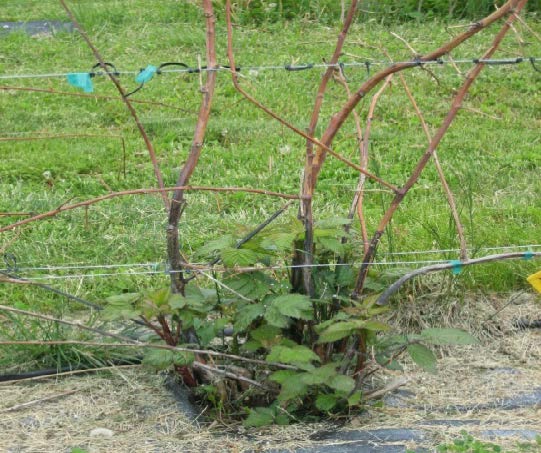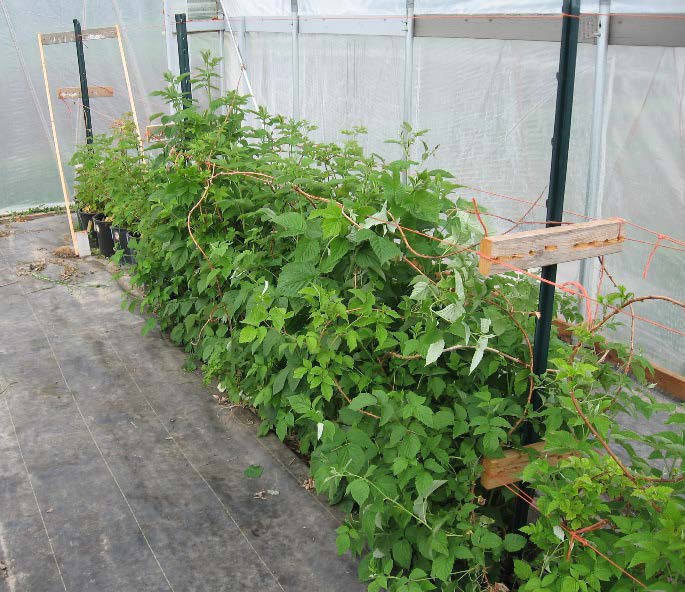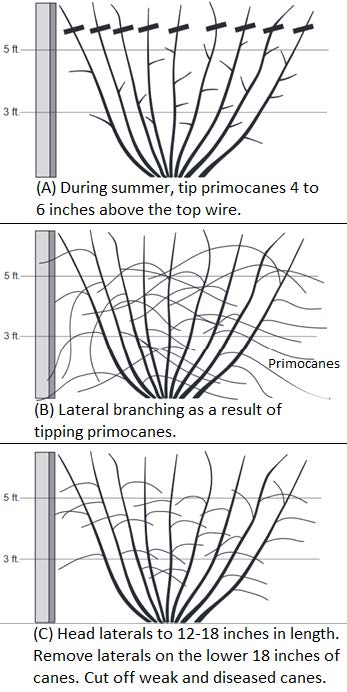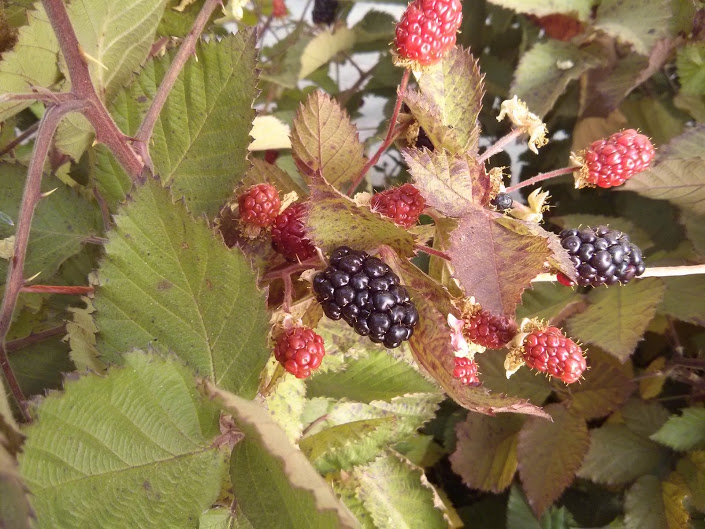Blackberry Management in Utah

Introduction
Blackberries can be grown successfully in Utah but careful cultivar selection and care is needed. Harsh winters and frequent late spring frosts often result in significant blackberry cane damage and crop loss. However, the delicate fruit have a short shelf life that makes shipping from distant markets difficult, presenting opportunities for local sales or as a special treat from the home garden. Blackberry plants have a perennial root system with biennial canes, meaning the root systems can live for many years, while individual canes live only 2 years. Blackberries are classified by fruiting type and growth habit.
Fruiting Type
Floricane-fruiting blackberries produce vegetative canes in the first year called primocanes. In the second year those same canes (now called floricanes) produce flowers and fruit. After fruiting, the floricanes die but are replaced by new primocanes that grew during the year. Typical harvest in Northern Utah begins in mid- to late-July, peaking in early August.
Primocane-fruiting blackberries can produce fruit on first year canes (primocanes). These start fruiting in late August and continue until fall freezes occur. Since the canes do not have to overwinter, winter hardiness is not a concern. However, fall freezes may halt production before full yield potential is reached.
Growth Habit
Blackberries are classified by growth habit into three categories: semi-erect, erect, and trailing.
Semi-erect blackberries have primocanes that initially grow erect, but then branch and the side branches droop down to the ground. When the shoot tips come in contact with the ground, the plants will tip layer (root down and form a new plant) which is an important consideration in trellising and management. Under northern Utah conditions, semi-erect types typically produce heavier yields than the erect and trailing types.
Erect blackberries are mostly self-supporting plants but still benefit from trellising. They spread by root suckers, making them capable of completely filling in a row over time. They produce long canes that need to be headed back to encourage side branching.

Fig. 1. Winter injured floricanes with new primocanes emerging
Trailing types produce long thin canes that will grow along the ground unless supported by an appropriate trellis. These plants do not spread by suckers, instead the canes are replaced by new growth arising from a single crown. Damage to canes and buds typically occurs once winter temperatures drop below 13 °F, a fairly common occurrence throughout much of Utah.
Blackberries often suffer from some cold injury in northern Utah, which typically results in loss of floricane buds, or dieback of the entire cane (Figure 1). As a general rule, trailing types of blackberries are the most cold sensitive, and semi-erect types are the most cold hardy. Although Utah winter conditions rarely cause permanent damage to the plant, floricane damage reduces or eliminates potential yields. There are many different cultivars of blackberries, some of which are more suited for Utah than others. Reference our Blackberry Cultivar Selection fact sheet for more information about cultivars that have performed well in Utah.
How to Grow
Site Selection
Blackberries require well-drained, deep soils to thrive. Planting into heavy clay soils can result in Phytophthora root rot and nutrient deficiencies. If drainage is poor, planting into raised beds and incorporating organic matter into the soil before planting can help alleviate the problem. For detailed instructions on making raised beds, reference our Raised Bed Gardening fact sheet. Planting in places that previously had solanaceous crops (tomatoes, peppers, potatoes), strawberries or other cane fruit may also increase the risk of soil borne pathogens. If possible, wait 3 to 4 years before planting blackberries in these sites in order to minimize the probability of disease.
Soil
To determine if amendments are needed, soil samples should be collected and analyzed before planting. The Utah State University Analytical Laboratory provides soil analysis and information on sampling procedures. Their information can be found at usual.usu.edu. Based on the soil analysis, recommended nutrients should be incorporated into the top 4 to 10 inches of soil. Perennial weeds should be controlled the summer before planting as they are difficult to manage once the blackberries have been planted.
Planting and Spacing
Bare-root dormant plants or tissue culturepropagated plug plants are transplanted in early spring, and should be purchased from reputable nurseries to ensure that plants are free of viruses and fungal diseases. If using bare-root plants, never allow roots to dry out. Before planting, soak the roots in water for 1 to 2 hours to improve establishment. Plant them at the same level they were planted before being dug (a soil line should be visible), and take care to cover the crown of the plant with soil. Spread roots out laterally along the row and water immediately. Plug plants should be transplanted later, after the risk of frost has passed. Rows should be 9 to 12 feet apart, with plants spaced 3 to 6 feet apart in the row, depending on cultivar.
Irrigation
Watering too early in the season often cools the soil, slows root growth, causes poor aeration, and induces iron deficiency yellowing. Once the soil has warmed and dried out in the top 2 to 3 inches, apply 1 to 2 inches of water per week. Blackberries have shallow, fibrous root systems that require regular irrigation. Inconsistent irrigation results in low primocane vigor, reduced fruit set, and poor fruit quality.
Drip irrigation, while expensive, is efficient, has low labor requirements, and produces large plants and high yields. Drip irrigation will reduce water use by applying water only where it is needed and minimize disease risks by keeping moisture off the foliage. Additionally, drip irrigation can minimize weed pressure since water is less available to weeds in the alleyways. Sprinkler irrigation causes wetting of canes and fruit, increasing the risk of foliar and fruit diseases. However, sprinkler irrigation is better than furrow because of the danger of overirrigation, and potential for spreading soil-borne diseases. Sprinkler irrigation can also allow for maintaining a grass cover crop in the alleyway to keep dust down and keep temperatures cooler.
Find more information about measuring soil moisture content and blackberry irrigation requirements in our Caneberry Irrigation fact sheet.
Fertilizer
After establishment, nitrogen is one of the most limiting nutrients for blackberries. Determine the quantity of needed nitrogen by evaluating shoot growth or by performing a soil test. For established plantings, apply 3 to 5 pounds of urea (45-0-0) or ammonium sulfate (21-0-0) per 100 feet of row. If shoot growth was reduced in the previous year apply at the high rate; if it was normal, 3 pounds per 100 row feet is more appropriate. Apply in early spring, preferably just before irrigating or predicted rain to move the fertilizer into the soil. Add other nutrients if soil tests indicate a need, or if deficiency symptoms become visible. Fertigation can be used with drip irrigation systems to apply small amounts of fertilizer at more frequent intervals, and would typically involve applying small amounts of N at weekly intervals from bud break until about midJuly. The following cultivars, presented in alphabetical order, may be suitable in Utah.
Trellising
With any of the three blackberry types, trellis systems are a good way to control cane growth, keep fruit off the ground, increase light penetration into the canopy, and make berries more accessible for harvest. You can grow erect blackberries without support, but a trellis will reduce cane breakage from wind and help keep the canes neat and easy to harvest.

Fig. 2. T-trellis, note three cross-arms are used with this
erect blackberry cultivar
Erect blackberries work well with a simple Ttrellis like the one shown in Figure 2. Use heavyduty, 8-foot end posts. Bury them securely into the ground every 20 feet. Connect a 3-foot-wide 2x4 to the posts to create a cross-arm and run wires (12 to 14 gauge galvanized) down each end of the cross arm. The cross arm should be about 3 to 4 feet above the ground. Blackberry canes should be trained between the wires as they grow.
Semi-erect blackberries are typically supported on a vertical trellis as shown in Figure 3. In this system, wires are installed at about 3 feet and 5 feet high along the post vertically and the canes are connected to the wire using trellising tape as they grow. Semi-erect types can also be trellised with a T-trellis as described above. Another level of wires can be useful with particularly vigorous cultivars. A 4-foot-wide cross arm installed 2 feet a above the 3- foot-wide cross arm helps keep the vines neat.
Trailing blackberries are effectively trellised with a vertical, two or more wire trellis. Train primocanes up to the top wire and loop the canes around the wires as they grow longer.

Fig. 3. Fan system of pruning and training semi-erect blackberries.
Diagram courtesy of University of tennessee Extension Publication
SP284-G, p.6.
Pruning Floricane-fruiting Blackberries
Semi-erect and erect blackberries require both dormant (winter) pruning and summer pruning or tipping. During the winter (usually February to March) remove the floricanes that fruited last summer. These are now dead and need to be removed to keep the planting clean. Next, shorten any excessively long lateral branches to 2 to 3 feet long. Summer tipping (pinching off the top 1 to 2 inches of growth on a cane) is slightly different between semi-erect and erect types. For semi-erect types, tip the new primocanes once they grow above the top wire. For erect types, tip the new primocanes when they are about 3 feet long. The canes will then branch and this is where the fruit will be produced the following year.
Trailing blackberries do not grow well throughout much of Utah because of severe winter cane damage. However, they may be an option for some of the warmest areas of the state. After the initial year of establishment, you will have trained the fruiting canes up to the wire. Allow the new primocanes to grow along the ground in a narrow row, directly below the wires. Remove all of the spent floricanes during winter and then loop the fruiting canes that grew along the ground during the previous summer around the trellis wires. Leaving the primocanes on the ground over the winter may improve winter survival, particularly if the canes are covered in snow or a mulch during the coldest temperatures, but production will typically be limited by winter cane dieback in most areas of northern Utah.
Pruning Primocane-fruiting Blackberries
As previously described, primocane-fruiting blackberries can produce fruit on first year canes during the late summer and fall. Allow canes to grow to 3 feet long and then tip in early summer. This will encourage branching and increase bud formation. Once the canes die after hard winter freezes, remove all canes down to the ground. One major advantage of primocane-fruiting blackberries is that winter hardiness of the canes does not matter since they are all removed for the winter. However, yields may be limited by early fall freezes.
Pests
To avoid pest problems, a healthy environment needs to be maintained. Weeds are a common pest with all crops, competing for nutrients and water, and harboring insects or diseases. Carefully controlling weeds will reduce the likelihood of insect and disease occurrences. Application of glyphosate or other systemic herbicides can be used to control perennial weeds during site preparation prior to planting. Cover crops can be grown during the year prior to planting to reduce weed populations. An early spring application of a preemergent herbicide will help reduce seedling germination but will have no effect on existing perennial weeds. Use of herbicides in an established planting requires careful planning, application, and careful attention to the precautions on the label. Applying a systemic herbicide to the area around the blackberries can be risky, as any part of the plant (including suckers) can take up the herbicide and transport it throughout the rest of the plant, causing damage. Only apply herbicides on calm days when temperatures will not exceed 90°F, to avoid volatilization and drift of the herbicide. Shielding the planting with a board while spraying reduces accidental exposure. Heavy-duty landscape fabric is effective for weed control for 4 to 6 years. However, it may interfere with primocane emergence.
Integrated pest management (IPM) uses several management practices (monitoring, biological, cultural, and chemical controls) as a method for safe and economical pest control. Proper identification and monitoring will narrow the chances of unnecessary pesticide use and help determine the appropriate control strategy. Chemicals should be used only in cases of severe plant damage where biological and cultural controls were unsuccessful. It is important to follow the label and wear appropriate personal protective equipment. A table of common blackberry pests is included below.
| Insect | Identification | Control |
|---|---|---|
| Larger Raspberry Aphid Amphorophora agathonica | Soft-bodied, fluid sucking insects that deplete plant nutrients, stunt vegetative and fruit growth and can spread diseases. Overwinters as eggs on canes. Many generations per year. | Monitor closely, checking under leaves. Encourage beneficial insects (such as lady beetles) and avoid applying pesticides that will damage them. Insecticidal soaps or oils should be used if plant health declines. |
| Dryberry Mite Phyllocoptes gracilis | Tiny, yellow/brown mites feed on undersides of leaves and cause yellow blotching. Often confused with sunscald symptoms. Overwinter in buds | Predator mites are effective natural controls. Apply lime sulfur in spring when buds are about 0.5 inch long and again in the fall. |
| Redberry Mite Acalitus essigi | Very tiny mites (20-30x mag. needed to see) overwinter within buds or under bud scales. Feed on developing fruit during summer. Produce a toxin that prevents ripening and drupelets stay hard, red or green. | Apply wettable sulfur after bud swell but before buds open. Or apply horticultural oil at 1-2% by volume when fruit are in green to first pink stage. Do not apply sulfur or oil within 30 days of each other. Apply in the evening during bloom to avoid contact with bees. |
| Rose Leafhopper Edwardsiana rosae | Adults are slender, yellow/white. Nymphs are small and pale white and move quickly. They feed on the underside of leaves, resulting in stippling. Heavy infestations will cause leaves to curl. | Malathion and pyrethrins can be used, but should be considered carefully as they will also affect beneficial insects. |
| Raspberry Crown Borer Pennisetia marginata | Adults are clear winged moths that look like a yellow jacket. Larvae are white with a brown head. Larvae bore into canes and reduce cane vigor or cause breakage at base of the cane. | Maintain by removing and burning of infested canes. For commercial use only: Bifenthrin, Chlorantraniliprole, or Diazinon should be applied before bud break and watered into the root zone. |
| Spotted Winged Drosophila Drosophila suzukii | This new pest resembles the common vinegar fly. They lay eggs inside ripe or unripe fruit. Not widespread across Utah, but has been found in Davis County. | Remove damaged or rotting fruit from crop. Place vinegar traps near and around the crop to monitor for their presence. Several chemicals are approved for blackberries. Rotation of chemical families is important to reduce chances of resistance. |
| Disease | Identification | Control |
|---|---|---|
| Gray Mold Botrytis cinerea | Gray fuzz and rot will develop from cool wet conditions on plants. | Avoiding over-irrigation and sprinkler irrigation to minimize water droplets accumulating on flowers and developing fruit will decrease disease occurrence. |
| Phytophthora Root Rot Phytophthora spp. | A fungus that stunts and weakens plant growth and can make blackberries more susceptible to winter injury. | Good drainage, water management and crop rotations are some of the best control methods. Fungicides approved for blackberries should be appropriately used, but not relied on for control. |
| Sunscald | Fruit can be damaged by excess heat. The result is dried drupelets that turn brown, while unaffected drupelets continue to mature. | Applying a 10-30% shade cloth will minimize sunscald. |
Harvest

Fig. 4. Blackberry fruit
Harvest crews may need training to be able to distinguish fully ripe blackberry fruit. Fruit turn black before they are completely ripe and are very tart. It is important to wait until the berry is fully ripe before harvesting. Ripe blackberries have a dull appearance and should easily separate from the cane. Physiologically mature, but still unripe berries do not easily separate from the cane and have a more shiny appearance than fully mature blackberries. Once picked, the berries should be packaged and cooled to 35 to 40°F as soon as possible to ensure quality and to maximize postharvest life. Blackberries can be kept at this temperature up to 1 week without a significantly decline in quality. Ripe fruit should be harvested at 2 to 3 day intervals.
References
- Alston, Diane. (2015). Raspberry crown borer. Utah State University Extension. http://extension.usu.edu/files/publications/facts heet/ENT-179-15.pdf
- Black, B., Hill, R., & Cardon, G. (2008). Caneberry Irrigation. Utah State University Extension. https://digitalcommons.usu.edu/cgi/viewconten t.cgi?referer=http://extension.usu.edu/publicati ons&httpsredir=1&article=2714&context=exte nsion_curall
- Black, B., Lindstrom, T., Hunter, B., Olsen, S., Hansen, S., & Maughan, T. (2016). Selecting blackberry cultivars for Utah. Utah State University Extension. https://digitalcommons.usu.edu/cgi/viewconten t.cgi?referer=https://www.bing.com/&httpsredi r=1&article=2657&context=extension_curall
- Caron, M., Hansen, S., Beddes, T., Davis, R., Alston, D., & Nischwitz, C. (2018). Redberry mite on blackberry. Utah State University Extension. Publication Pending.
- Lockwood, D.W. (2014). Pruning and training caneberries (blackberries and raspberries). University of Tennessee Extension SP284-G. https://extension.tennessee.edu/publications/Do cuments/SP284-G.pdf
Utah State University Extension
Peer-reviewed fact sheet
Download PDF
Authors
Tiffany Maughan, Shawn Olsen, and Brent Black
Related Research







